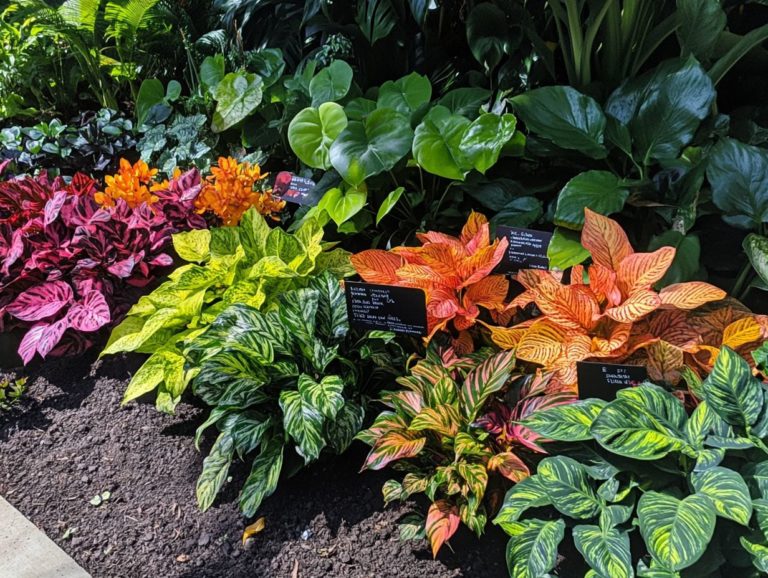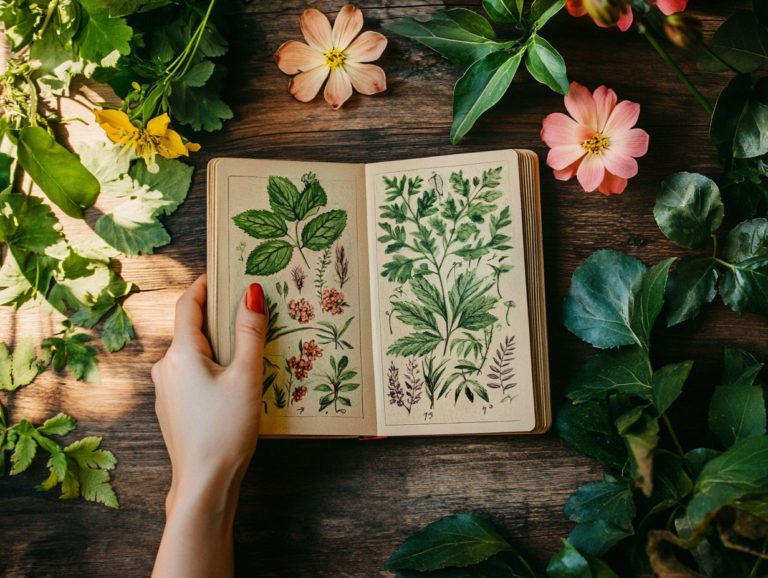Identifying Wild Edibles Throughout the Year
Wild edibles are nature’s hidden treasures, providing you with a delightful array of flavors and nutrients right beneath your feet.
Foraging for these plants not only enriches your diet but also strengthens your bond with the environment. Discover amazing benefits of wild edibles that will transform your meals and your connection to nature!
Learn when and where to find these culinary gems, how to identify them safely, and discover some delectable ways to prepare them. Embrace the art of foraging while actively promoting conservation practices that respect and honor our natural world.
Contents
- Key Takeaways:
- Why Foraging is Beneficial
- When and Where to Find Wild Edibles
- Identification and Safety Tips
- Preparing and Cooking Wild Edibles
- Conservation and Sustainability
- Frequently Asked Questions
- What is the best way to identify wild edibles throughout the year?
- Are there any plants that are safe to consume all year round?
- What are some common mistakes people make when identifying wild edibles?
- Can I rely on online sources for identifying wild edibles?
- What should I do if I’m unsure about the safety of a wild edible?
- What safety precautions should I take when foraging?
Key Takeaways:

- Identifying wild edibles enhances nutrition and supports the environment.
- Season and location are crucial for finding these plants.
- Always learn to distinguish between edible and non-edible plants before consuming.
Discovering Wild Edibles
Wild edibles are the delightful, naturally occurring plants and mushrooms that are perfectly safe for you to consume. Think of dandelions, morel mushrooms, and elderberries just a few of the many species you can discover in various environments.
Each plant has its own unique identifying features, which can vary widely depending on where you are. By understanding wild edibles and knowing the best times to gather, you not only deepen your connection to nature but also embrace sustainability and healthier eating habits.
Among the gems of wild edibles, you’ll find wild garlic, with its distinctive aroma and culinary flexibility, and bilberry, bursting with sweet, antioxidant-rich berries. To recognize these plants, it’s important to familiarize yourself with their identifying traits, such as leaf shape, color, and habitat, as discussed in understanding seasonal changes in edible plants.
Join a local foraging group for tips on safe harvesting and preparation. These communities are essential for nurturing a love of foraging, allowing you to explore the rich diversity of local flora while also learning about the cultural significance and ecological impact of your choices.
Why Foraging is Beneficial
Foraging for wild edibles presents a wealth of benefits, enhancing your nutrition while positively impacting the environment. This practice deepens your connection to local ecosystems, allowing you to appreciate the intricate web of life around you.
Foraging enriches your understanding of food sources and cultivates a sense of community among fellow foragers. These groups often share invaluable insights about the best practices for harvesting and identifying plants, creating a shared journey of discovery and knowledge.
Nutritional and Environmental Advantages
The nutritional advantages of wild edibles are truly remarkable, often boasting higher levels of vitamins and minerals than their cultivated counterparts. Foraging for plants like glasswort and beach rose not only elevates your diet but also promotes an eco-friendly lifestyle that champions variety of plants and animals and taking care of our resources.
By incorporating these wild ingredients into your meals, you can explore a delightful array of unique flavors and textures while tapping into traditional uses that have been passed down through generations. Take, for example, the seaweed found along coastlines, which is packed with iodine and other essential trace elements for thyroid function.
Engaging in foraging deepens your connection to local ecosystems and enhances your understanding of seasonal cycles and the importance of protecting habitats that support these invaluable resources.
When and Where to Find Wild Edibles

To forage for wild edibles successfully, it’s important to know when and where to find them. Understanding edible plant seasons is key, as different plants and mushrooms have their own seasonal schedules and habitat preferences.
For example, morel mushrooms flourish in the damp, wooded areas of early spring. In contrast, dandelions frequently grace sunny, open spaces throughout the growing season. Understanding these details elevates your foraging experience.
Seasonal Availability and Habitat
The seasonal availability of wild edibles varies significantly. Certain plants and mushrooms peak at specific times of the year, and it’s essential to familiarize yourself with their habitats by identifying wild edibles in your local area.
Wild garlic thrives in early spring, while rose hips can be harvested in late summer and fall, depending on the climate.
Knowing your local ecosystem is key to successful foraging. In temperate woodlands, morels flourish in the moist conditions of April, and charming chanterelles can often be found in damp, coniferous forests during summer. However, if you’re interested in foraging during colder months, learning about winter foraging can help you find edibles even in winter.
In wetlands and along riverbanks, watercress tends to thrive in the cooler spring waters, adding a refreshing touch to your meals. Each season offers its unique bounty, but specific soil types and weather conditions are essential for locating these wild ingredients.
Being aware of these factors can greatly enhance your foraging experience and lead to a more abundant harvest.
Identification and Safety Tips
Learning to identify wild edibles correctly is crucial for your safety and well-being. To enhance your foraging skills, check out seasonal foraging: the best times to gather edibles, as toxic look-alikes can cause harmful allergic reactions.
By understanding the distinct features of plants and mushrooms, you’ll gain the knowledge needed to distinguish safe edibles from potentially dangerous species. This knowledge boosts your foraging skills and helps you enjoy nature’s bounty confidently.
How to Properly Identify and Avoid Poisonous Plants
Properly identifying and avoiding poisonous plants is essential for anyone interested in foraging wild edibles. Misidentification can lead to severe health consequences, so familiarize yourself with the basics of foraging and the features of edible plants like common juniper and bilberry versus their toxic look-alikes.
Utilizing field guides and mobile apps can significantly elevate your foraging game. These tools offer visual references and detailed descriptions for accurate identification, including regional plant lists and handy search functions.
Participating in foraging workshops provides practical experience and connects you with seasoned foragers who can share invaluable tips. Engaging with community platforms allows you to exchange knowledge with fellow enthusiasts, creating a supportive environment to learn how to distinguish safe flora from harmful ones.
Preparing and Cooking Wild Edibles

Preparing and cooking wild edibles requires distinctive methods that enhance their flavors and preserve their nutritional value, ensuring a delightful culinary experience.
Techniques for cooking plants like common nettle and mushrooms such as velvet shank may vary. Many recipes emphasize simple preparations that showcase their inherent qualities.
Embrace the art of elevating these natural treasures in your kitchen.
Start your foraging journey today and discover nature’s delicious gifts!
Methods and Recipes for Delicious Dishes
You have a wealth of options when it comes to preparing delicious dishes with wild plants you can collect. Options range from simple saut ing to intricate preparations that highlight their distinctive flavors.
Recipes featuring ingredients like dandelion greens or Pacific oyster mushrooms can elevate your everyday meals into extraordinary culinary experiences. By experimenting with various cooking techniques think roasting, pickling, or even fermenting you can unlock a stunning array of tastes and textures.
Pair these ingredients with complementary flavors, such as the earthiness of quinoa or the creaminess of goat cheese, to enhance your dishes while celebrating nature’s bounty. Cooking with wild edibles is a thrilling adventure filled with endless possibilities!
Conservation and Sustainability
Conservation and sustainability are vital when it comes to foraging. Responsible practices ensure that wild edibles will be accessible for future generations. Act now to protect these resources!
By understanding the balance of ecosystems and following how to collect plants responsibly, you can embrace the joys of foraging while minimizing your environmental footprint. This mindful approach allows you to enjoy nature’s bounty without compromising its integrity.
Practices for Responsible Foraging
Practicing responsible foraging requires you to understand the ecosystem. Ensure that wild edibles are harvested sustainably without depleting vital resources. Taking only small portions and utilizing community crowdsourcing can greatly bolster conservation efforts.
Familiarize yourself with local regulations and guidelines governing foraging practices to safeguard both plants and animals. Joining local foraging groups sharpens your skills and fosters collaboration in conservation initiatives.
These communities often host workshops and guided foraging trips aimed at raising awareness about the importance of sustainability. Engaging with these groups cultivates a sense of stewardship and allows you to share insights on ethical harvesting methods.
By educating others about respectful foraging practices, you can collectively ensure that future generations enjoy access to nature s bounty while preserving the delicate balance of local ecosystems.
Frequently Asked Questions

What is the best way to identify wild edibles throughout the year?
The best way to identify wild edibles throughout the year is to familiarize yourself with local plants and their growth patterns. For more detailed information, check out what wild edibles are available year-round and keep track of which plants grow during which seasons while researching their edible properties.
It’s also helpful to take photos or make notes of the plants you come across to refer back to in the future.
Are there any plants that are safe to consume all year round?
Yes, some plants can be safely consumed throughout the year, such as dandelion, chickweed, and wild garlic. For a more comprehensive understanding of what you can forage, refer to our seasonal guide: foraging through the year. These plants have a longer growing season and can often be found in abundance in many regions.
What are some common mistakes people make when identifying wild edibles?
A common mistake is mistaking poisonous plants for edible ones. It’s crucial to thoroughly research the plants in your area before consuming them.
Another mistake is not properly identifying the plant, as some have edible parts while others may be toxic.
Can I rely on online sources for identifying wild edibles?
Online sources can be a helpful starting point, but it’s best to cross-reference your findings with multiple sources and confirm the identification with an expert.
Some plants may have lookalikes that can be easily mistaken for the edible variety.
Try foraging with friends this season and discover the joy of wild edibles!
What should I do if I’m unsure about the safety of a wild edible?
If you’re unsure about a wild edible’s safety, be careful and don’t eat it. Consult a local foraging expert or join a workshop to learn about plants in your area.
What safety precautions should I take when foraging?
Yes, always identify the plant before eating it. Forage only in clean areas, away from roadsides and pesticide use.
Your safety is paramount let’s make sure you’re foraging safely! Always wash your hands and the plants thoroughly before consumption.






